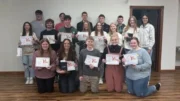CLARION – Clarion University President Karen Whitney has traditionally issued a list of goals and desired outcomes for 19 months which she calls her “500-day plan.”
Whitney reported on the outcomes of her third set of 500-day plans and recently outlined her fourth 500-day plan to the university’s Council of Trustees.
She said the university underwent a lot of change in recent months and had many obstacles to overcome and is now looking at ways to move forward.
The past 500 days
In the plan that covered November 2014 through May 2016, two-thirds of the 33 proposed actions achieved the desired results, a quarter of the actions were completed and three actions had not been started.
Many of the action items were ongoing – achieving their desired results while still classified as “in progress.”
Another six actions were in progress while not achieving desired results.
Priority one was to increase student enrollment and graduation; CUP achieved four of six desired results.
Those results included developing the Blueprint Communities initiative, serving on the board of the Residual Rural Community College now in the planning stages, implementing a plan for new educational programs and reorganizing the enrollment management department.
The goals not met but in progress include teaming faculty with admissions personnel to meet desired student enrollment targets and using alumni to help with student recruitment, career development and job placement.
Priority two was about finances, and the university met five of its eight goals, but significantly, did not reach the goal of ensuring a stable operating budget, though there were “sweeping reductions in expenses.”
Community engagement was priority three and CUP reached seven of eight goals; these include continuing to work with the Blueprint Communities and the Rural Community College board.
Priority four was to create equitable and diverse environments. Three goals were met – developing a diversity plan, holding meetings to review the progress of the plan and issuing a presidential award for diversity. One proposed action, investing in the strategic diversity plan, was not begun.
Priority five involves leadership, with two main goals – to develop an effective administrative team and to communicate the priorities and goals of the university.
The reports state the university achieved the desired result of establishing an administration that has “earned the confidence of the majority of the faculty and the staff.”
A report issued this spring by the faculty union, however, showed 60 percent of the faculty calling for a vote of no confidence in Whitney and 67 percent calling for such a vote on former provost Ron Nowaczyk.
Nowaczyk left in May to take a position as president of Frostburg State College in Maryland.
The report says there are ongoing efforts to build and strengthen relationships with faculty and that students, faculty and staff were invited to join in discussions. A goal to survey faculty, staff and student perspectives was not begun.
The next 500 days
The next 500-day plan has five priorities; priorities one, two and five are similar to the previous plan – to increase enrolment and graduation rates; to improve the university’s financial situation and to strengthen the administrative team.
There are two new priorities involving faculty relations and new academic programs.
Priority one would commission an enrollment plan, search for a new associate vice president for enrollment, infuse high impact practices into the curriculum, prepare students for employment and increase the number of students enrolling, continuing and graduating.
Priority two would lobby for more state funding, conduct a private fundraising campaign, develop an approach to setting fees, review business practices and conserve resources.
Priority three, faculty and staff development and success, involves improving relations with faculty and staff, improving relations with the university’s unions, and reviewing the professional development programs.
Priority four, academic program distinctiveness and quality, includes developing and launching new, in-demand academic programs and ensuring current programs are rigorous, relevant, in-demand, and financially sustainable.
Priority five, to review and strengthen the university leadership team, has the single goal of “the appointment a high quality, academically oriented provost through conducting a competitive national search.”








































